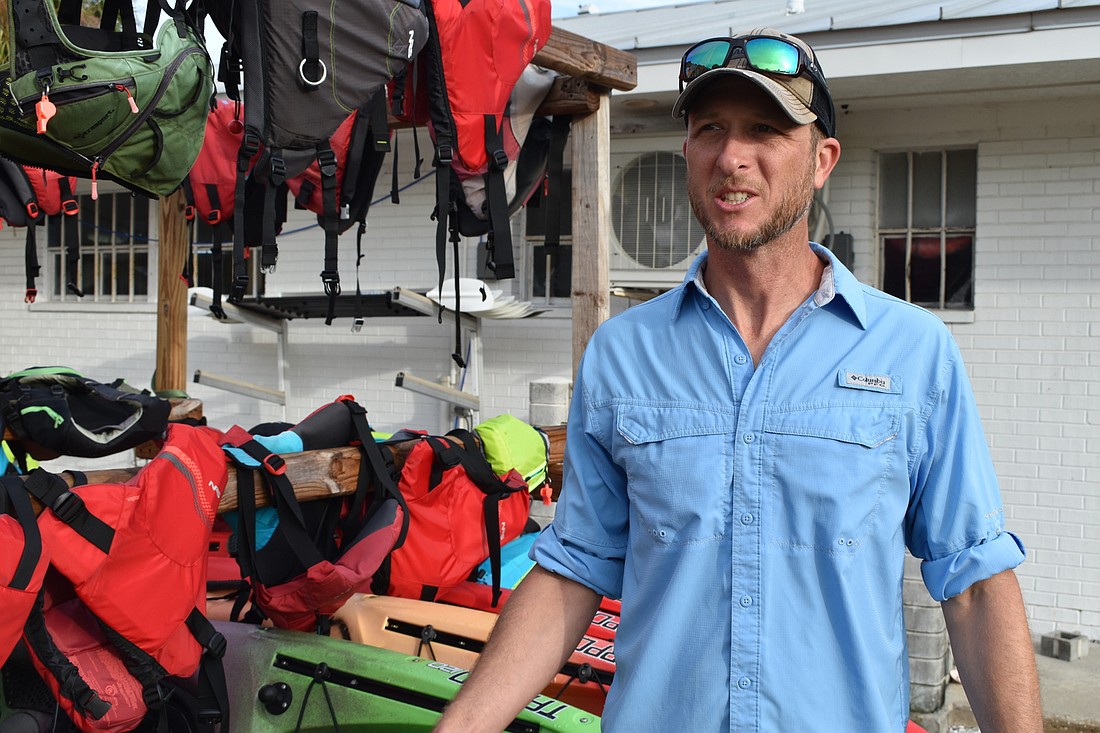- April 30, 2025
-
-
Loading

Loading

Shane Catts can recall what Sarasota Bay looked like decades ago.
The 40-year-old owner of Happy Paddler Kayak Tours remembers visiting his grandparents, who used to live right behind his current business in Bayfront Park.
“They no longer live there, but so I grew up playing up here, and so I can see the changes that have occurred in the last 40 years,” Catts said. “I mean, it’s very apparent. It has me gravely concerned for the long-term future of the bay.”
In a recent report to the town, Sarasota Bay Estuary Program Executive Director David Tomasko said his organization has found higher values of nitrogen and chlorophyll in recent years in the Sarasota Bay waters, leading to his organization's concerns about algae blooms. He also mentioned how Sarasota Bay has seen a significant reduction in seagrass coverage.
In 2019, Sarasota Bay received from the organization a 2.25 score out of 4. The Bay got a 1.75 in 2018. The two scores measuring the bay’s health were the lowest recorded by the Sarasota Bay Estuary Program’s report card system, which dates back to 2006.
Tomasko says the scores are attributed to the 2018 red tide outbreak and potential effects from the Piney Point leak.
“In 2018 when you had the red tide, when you had fish kills and smelly water and flies everywhere, the economy sucked, and it did in part because no one wanted to be by the bay,” Tomasko said. “The point I guess is, it doesn’t have to be just red tide.''
Longboat Key's proximity to the bay connects the water body's health and success to many facets of island life and business.
“It means everything,” Cannons Marina owner David Miller said. “Without it, we don’t have a bay and we don’t have any good reason to be boating here. Like during the times with really bad red tide, nobody’s interested in even being on this island. So, that’s extreme on one end.”
Catts said red tide was only a problem every seven to 10 years growing up. He said it happens more frequently now.
“Now, you look at the map and you see it all up and down the coast on an annual basis,” Catts said.
Catts said in 2018 Happy Paddler had to shut down for several weeks, but he considers himself lucky.
“Luckily for us as a business, the algae blooms usually do occur in the rainier seasons, which occur outside of our busiest times of the year,” Catts said. “However, for the next year, I was getting calls every single day, saying, ‘I’ve read about red tide. Is it still there?’
“It’s like, ‘No, it was gone a year ago.’ I’ll still get calls now.”
Suncoast Waterkeeper board member Rusty Chinnis explained how the red tide of 2018 compared to others in the decades he’s spent in the area.
“The ’17-’18 red tide, that is what I think was the sort of the nail in the coffin so to speak because I’ve seen a lot of red tides over the years, and they’re all really devastating,” Chinnis said. “As you well know if you’re around here, everybody’s up in arms, ‘We got to do something about this. We just can’t have this.’
“And then, it goes away and nobody talks about it. And therefore, nothing gets done and it just keeps getting worse, which is what’s happening. That ’17-’18, that red tide, this Bay has never recovered from that one.”
Beyond the environmental impact of the water and the surrounding marine life, there is an economic tie to a healthy Sarasota Bay:
“If proximity to the Bay is no longer an amenity, if nobody wants to buy that house because it smells bad . . . it’s going to affect local government budgets,” Tomasko said.
One of the ways residents can make a difference is to avoid over-fertilization of their yards, Tomasko said. The town has an ordinance banning the application of fertilizers containing nitrogen or phosphorous between June 1 and Sept. 30. A countywide ordinance covers unincorporated areas.
Tomasko said he’s seen several areas in Florida benefit from a wet season fertilizer blackout period.
“Not fertilizer, but the over-application of fertilizer can be problematic,” Tomasko said. “So, [homeowners] can be part of the problem or part of the solution.”
Tomasko said local governments can educate people on the value of being careful about fertilizer application.
Citing the town’s June 2020 sewage leak, Tomasko is also a proponent of the town prioritizing a redundant underwater sewer line project, which has an estimated cost of $21.8 million.
“Fortunately, that leak was in the mangrove fringe,” Tomasko said. “It probably didn’t cause much of a problem. If it was in the middle of the Bay, that would’ve been harder to find [and] harder to fix. If it was in the middle of the bay during a Lyngbya bloom or a red tide, it might be an awful thing.”